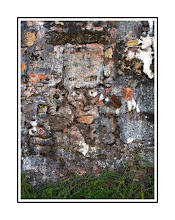
It has been too long since I posted, lets just say there have been software issues and leave it at that. Between then and now, the Tin Mining areas of Cornwall and Devon have been granted World Heritage Status.
The image here was formed as a result of mineral deposits leaching from the walls of mine buildings. Some might see these as the faces of mine spirits known as Knockers. These mischievous creatures were the constant companions of miners, warning them of imminent danger, woe betide those who chose to ignore them. Now mining has all but ceased have these mischievous spirits appeared on the surface to keep a watchful eye?
I seems to me that, like most so-called Heritage projects, the social history is too often obscured. It often favours the wealth creators at the expense of those who laboured to create it. The folklore is regarded as quaint but within it there lies an insight to the psyche of those who laboured in the dark reaches in search of tin and copper.
A local councillor, Henry Eva, told me his uncle was killed in a mining accident here in West Cornwall. On a death in the mine, the men would gather underground and sing hymns, their voices rising to the surface from the many shafts.
When it was decided to 'Tidy Up' the old mining areas with the use of Contaminated Land grants there was much outcry. A unique landscape with its associated rare fauna and flora along with mining archaeology, was set to be irreparably damaged, according to some.
Henry felt they should tread carefully, "To me these places are sacred ground" he said, "When I walk over them I hear the voices of the miners singing for all the lost souls."
This is what sits at the back of my mind and guides me when I am out with my camera, I see the faces of the forgotten and their silence is deafening.


